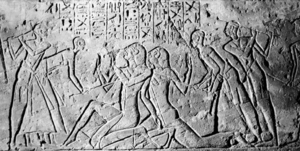
The Kadesh inscriptions or Qadesh inscriptions are a variety of Egyptian hieroglyphic inscriptions describing the Battle of Kadesh (1274 BC). The combined evidence in the form of texts and wall reliefs provide the best documented description of a battle in all of ancient history.[1]
The Egyptian version of the battle of Kadesh is recorded in two primary accounts, known as the Bulletin or Report and the Poem which are often placed side by side in the locations they were inscribed. In addition, some reliefs also inscribed in the same location offer pictorial depictions of the battle. Some scholars divide these accounts into three. The Bulletin is repeated seven times and the Poem eight times, spread across temples in Abydos, Temple of Luxor, Karnak, Abu Simbel and the Ramesseum, and two hieratic papyri.[2]
- ^ Ockinga 1987, p. 38: "No battle fought in antiquity is so well-documented as the clash between the Egyptians and the Hittites before the city of Kadesh on the Orontes in 1275 BC"
- ^ Lichtheim 1973, p. 57: "Subsequently the campaign was told al length in two separate accounts which scholars have called the Bulletin (or the Record) and the Poem. The two accounts are supplemented by pictorial reliefs with explanatory captions. The whole composition offers a number of striking features. First the fact that there are two distinct though overlapping accounts. Second the fact that the two versions were not merely carved once on the walls of a temple but were repeated in multiple copies – the Bulletin seven times and the Poem eight times. They are inscribed on the walls of the temples of Abydos, Luxor, Karnak, Abu Simbel and the Ramesseum, and the Poem is also found on fragments of two hieratic papyri.
© MMXXIII Rich X Search. We shall prevail. All rights reserved. Rich X Search
